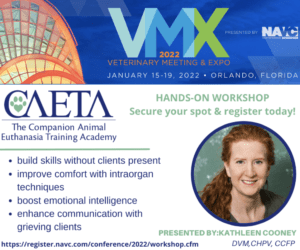In Person Training
In-person Master Program training consists of a combination of lecture and laboratory sessions over 1.5 days. During this time, discussions about real-life obstacles are stimulated and networking opportunities are provided for. This format is the most comprehensive with the highest level of education we can provide students. See Upcoming Courses to learn more. If you are seeking the best CAETA learning experience, this is it. Our online program is also wonderful and well adapted for those unable to attend our live classes.
Want to take the laboratory portion of the program following completion of the online program? CAETA is proud to offer complementary laboratory registration at our stand alone events for online program graduates. In person laboratories are held in Colorado. Other events include Fetch 360 conferences around the US and the VMX annual conference in Orlando, Florida.
Onsite Master Program: Day One
Overview of Companion Animal Euthanasia
Abstract
Euthanasia is a very broad and diverse procedure with deep history and ethical implications. For decades, the veterinary profession has been evolving the act of taking life to match current welfare and societal demands. In this hour, we will explore the history of euthanasia as it pertains to all species, review our country’s euthanasia guidelines, and examine the ethics behind it all.
Learning Objectives for this hour.
- Comprehend the broad history of animal euthanasia
- Understand how the methods we use today have come about
- Appreciate ethical nuances around this sensitive topic
Caregiver and Pet Considerations
Abstract
A large component behind CAETA’s development is to teach ways to support those who love companion animals. There are numerous caregiver considerations that affect exactly why and how we perform euthanasia. In this hour, we will discover how to partner and guide caregivers through such a difficult, emotional time with focus on keeping the pet patient safe and supported throughout.
Learning Objectives for this hour.
- Apply client communication techniques for increased clarity
- Better assist clients preparing for the euthanasia experience
- Offer more empathy and support for the bereaved
Physiology and Pharmacology
Abstract
Euthanasia is a process requiring more comprehension than just knowing how to give an injection. As with any procedure, it’s important to know how it works and how we achieve a peaceful passing. In this hour, we will examine the physiology of death and learn just how the drugs we use work on the body.
Learning Objectives for this hour.
- Explain the stages of dying
- Better recognize what are normal and abnormal reactions to drugs
- Understand how euthanasia drugs accomplish death
Pre-euthanasia Sedation/Anesthesia Protocols
Abstract
The use of pre-euthanasia sedation or anesthesia to relax companion animals is becoming more and more common. Veterinary teams around the world are seeing the benefits of providing a more peaceful and anxiety-free experience. We will examine pros and cons to their use and review protocols that can be immediately implemented in practice.
Learning Objectives for this hour.
- Determine when to reach for a sedative protocol versus an anesthetic
- Explain expected physical changes to clients
- Quickly modify protocols to meet the patient’s unique needs
Euthanasia Techniques
Abstract
Euthanasia requires more skill than just giving an injection. There are 5 common injection sites for use in most companion animals; IV, IC, IP, IR, IH. The goal is to reach for the best one given the situation. Our goal during this hour is to review these 5 injection types and have a bit of time to review inhalation of anesthetics and physical methods, should the need ever arise. All injection techniques can be practiced during the techniques laboratory.
Learning Objectives for this hour.
- Effectively administer euthanasia solution using each technique
- Make better decisions towards technique selection
- Administer inhaled anesthetics or direct physical methods if necessary
Challenging Situations
Abstract
Even the best taught, most prepared practitioner is going to come across a challenging situation from time to time. While we want everything to go perfectly smooth, truth is things must go wrong every once and a while. It’s how we handle these challenging situations that makes the difference between a terrible experience and a beautiful one. We will talk openly during this hour about unexpected results, special circumstances, and challenges of all kinds.
Learning Objectives for this hour.
- Breathe easier knowing they are not alone. Everyone faces difficult cases.
- Troubleshoot quickly to provide a peaceful passing
- Better explain to clients why the challenge/issue occurred
Case Review
Abstract
Everyone learns best through real world case review. The cases presented will be typical to daily in-clinic and mobile practice and include all companion animals, including exotics and companion livestock. There should be time to review student cases as well.
Learning Objectives for this hour.
- Apply what they learned into their own cases
- Troubleshoot quickly to provide a peaceful passing
- Better understand companion livestock euthanasia
Onsite Master Program: Day Two
Laboratory (part 1 of 2) - Hands-on experience using cadavers
Abstract
This 2-hour laboratory will provide hands on euthanasia practice using companion animal cadavers. Participants will be able to isolate venous pathways, practice organ injections on visible organs, make paw prints and ink prints, test out various supplies, and much more. This is an opportunity to learn the anatomy again and gain invaluable technique training from the instructor and other participants alike.
Learning Objectives for this hour.
- More confidentally administer via the intraorgan route
- Choose the best vein to work with
- Provide respectful body handling and memorialization
Laboratory (part 2 of 2) - Hands-on experience using cadavers
Abstract
This 2-hour laboratory will provide hands on euthanasia practice using companion animal cadavers. Participants will be able to isolate venous pathways, practice organ injections on visible organs, make paw prints and ink prints, test out various supplies, and much more. This is an opportunity to learn the anatomy again and gain invaluable technique training from the instructor and other participants alike.
Learning Objectives for this hour.
- More confidentally administer via the intraorgan route
- Choose the best vein to work with
- Provide respectful body handling and memorialization
Euthanasia Supplies and Material Review
Abstract
This final hour of our course will outline all the necessary supplies for both the hospital and mobile setting. Being prepared for all scenarios is the secret to success. It brings peace of mind and helps ensure the veterinary team is able to successfully complete the procedure. No detail is too big or too small.
Learning Objectives for this hour.
- Design their supply kit to hold all necessary medical supplies
- Incorporate pet loss support material
- Purchase supplies more wisely to reduce waste

Please see our Frequently Asked Questions page or contact us with any questions regarding the course outline, or get started today by registering.


